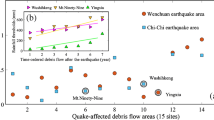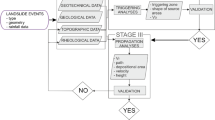Abstract
This study describes a combined method for rainfall-induced debris flow initiations (landslides) and propagations including a series of numerical analyses. In this study, the debris is assumed as a mixture of soils and water which is physically non-Newtonian fluid. The emphasis is placed on applying the effect of the combination of rainfall-induced landslides and debris flows to the numerical analysis. An analysis of rainfall-induced landslides is conducted to identify the thickness and location of the initial volume of debris flow. The movement of debris flow is subsequently simulated considering entrainments affected by the initial wetting condition (wetting front) estimated from the rainfall-infiltration analysis. The proposed method can simulate a sequential process from the initiation of the debris flows to the deposition based on the prediction of slope failure by rainfall, fluid dynamics based on Navier–Stokes equation, and the analysis of entrainments by considering the effect of the weight of debris and the wetting condition of soil beds. Based on the numerical results of this study, the proposed method could be applied to the analysis of regional-scale landslides and debris flows.




















Similar content being viewed by others
References
Betsuyaku T, Munakata M, Yamaguchi E, Ohe S, Hizawa N, Sukoh N et al (1994) Establishing diagnosis of pulmonary malignant lymphoma by gene rearrangement analysis of lymphocytes in bronchoalveolar lavage fluid. Am J Respir Crit Care Med 149(2):526–529
Bouchut F, Westdickenberg M (2004) Gravity driven shallow water models for arbitrary topography. Commun Math Sci 2(3):359–389
Bru G, Fernández-Merodo JA, García-Davalillo JC, Herrera G, Fernández J (2018) Site scale modeling of slow-moving landslides, a 3D viscoplastic finite element modeling approach. Landslides 15(2):257–272
Christen M, Kowalski J, Bartelt P (2010) RAMMS: Numerical simulation of dense snow avalanches in three-dimensional terrain. Cold Reg Sci Technol 63(1-2):1–14
Fredlund DG, Morgenstern NR, Widger RA (1978) The shear strength of unsaturated soils. Can Geotech J 15(3):313–321
Hungr O (1995) A model for the runout analysis of rapid flow slides, debris flows, and avalanches. Can Geotech J 32(4):610–623
Iverson RM, Denlinger RP (2001) Flow of variably fluidized granular masses across three-dimensional terrain: 1. Coulomb mixture theory. J Geophys Res Solid Earth 106(B1):537–552
Jakob M, Friele P (2010) Frequency and magnitude of debris flows on Cheekye River, British Columbia. Geomorphology 114(3):382–395
Jakob M, Hungr O, Jakob DM (2005) Debris-flow hazards and related phenomena, 739th edn. Springer, Berlin. https://doi.org/10.1007/b138657
Jeong S, Kim Y, Lee JK, Kim J (2015) The 27 July 2011 debris flows at Umyeonsan, Seoul, Korea. Landslides 12(4):799–813
Kim H, Lee SW, Yune CY, Kim G (2014) Volume estimation of small scale debris flows based on observations of topographic changes using airborne LiDAR DEMs. J Mt Sci 11(3):578–591
Kim J, Kim Y, Jeong S, Hong M (2017) Rainfall-induced landslides by deficit field matric suction in unsaturated soil slopes. Environ Earth Sci 76(23):808
Koo RCH, Kwan JSH, Ng CWW, Lam C, Choi CE, Song D, Pun WK (2017) Velocity attenuation of debris flows and a new momentum-based load model for rigid barriers. Landslides 14(2):617–629
Legros F (2002) The mobility of long-runout landslides. Eng Geol 63(3-4):301–331
McDougall SD, Hungr O (2003) Objectives for the development of an integrated three-dimensional continuum model for the analysis of landslide runout. In Proceedings of the 3rd International Conference on Debris-Flow Hazards Mitigation: Mechanics, Prediction and Assessment, Davos. Millpress, Rotterdam, Netherlands 481-490.
Medina V, Hürlimann M, Bateman A (2008) Application of FLATModel, a 2D finite volume code, to debris flows in the northeastern part of the Iberian Peninsula. Landslides 5(1):127–142
Mein RG, Larson CL (1973) Modeling infiltration during a steady rain. Water Resour Res 9(2):384–394
Morgenstern NR (1978) Mobile soil and rock flows. Lecture given at the fifth Southeast Asian Conference on soil engineering, Bangkok, July 1977. Geotech Eng 9(2):123–141
Nilaweera NS, Nutalaya P (1999) Role of tree roots in slope stabilisation. Bull Eng Geol Environ 57(4):337–342
O’Brien JS, Julien PY, Fullerton WT (1993) Two-dimensional water flood and mudflow simulation. J Hydraul Eng 119(2):244–261
Pastor M, Quecedo M, González E, Herreros MI, Merodo JF, Mira P (2004) Simple approximation to bottom friction for Bingham fluid depth integrated models. J Hydraul Eng 130(2):149–155
Pastor M, Blanc T, Haddad B, Petrone S, Morles MS, Drempetic V, Issler D, Crosta GB, Cascini L, Sorbino G, Cuomo S (2014) Application of a SPH depth-integrated model to landslide run-out analysis. Landslides 11(5):793–812
Pierce JL, Meyer GA, Jull AT (2004) Fire-induced erosion and millennial-scale climate change in northern ponderosa pine forests. Nature 432(7013):87
Pudasaini SP, Hutter K (2003) Rapid shear flows of dry granular masses down curved and twisted channels. J Fluid Mech 495:193–208
Rahman MA, Konagai K (2017) Substantiation of debris flow velocity from super-elevation: a numerical approach. Landslides 14(2):633–647
Rickenmann D (1999) Empirical relationships for debris flows. Nat Hazards 19(1):47–77
Rickenmann D, Laigle DMBW, McArdell BW, Hübl J (2006) Comparison of 2D debris-flow simulation models with field events. Comput Geosci 10(2):241–264
Savage SB, Hutter K (1989) The motion of a finite mass of granular material down a rough incline. J Fluid Mech 199:177–215
Scheidegger AE (1973) On the prediction of the reach and velocity of catastrophic landslides. Rock Mech Rock Eng 5(4):231–236
Scheidl C, Rickenmann D (2010) Empirical prediction of debris-flow mobility and deposition on fans. Earth Surf Proc Landforms: The Journal of the British Geomorphological Research Group 35(2):157–173. https://doi.org/10.1002/esp.1897
Stoffel M, Beniston M (2006) On the incidence of debris flows from the early Little Ice Age to a future greenhouse climate: a case study from the Swiss Alps. Geophys Res Lett 33(16)
Takahashi T (1991) Debris flows, IAHR Monograph Series, Disaster Prevention Research institute. Kyoto University 83-99.
Takahashi T (2014) Debris flow: mechanics, prediction and countermeasures. CRC. https://doi.org/10.1201/b16647
Takahashi T, Tsujimoto H (1984) Numerical simulation of flooding and deposition of a debris flow. DPRI Ann 27B-2:467–485
Takahashi T, Nakagawa H, Harada T, Yamashiki Y (1992) Routing debris flows with particle segregation. J Hydraul Eng 118(11):1490–1507
Voellmy A (1964) On the destructive force of avalanches. Alta Avalanche Study Center.
Wu W, Sidle RC (1995) A distributed slope stability model for steep forested basins. Water Resour Res 31(8):2097–2110
Funding
This work was supported by the Basic Science Research Program through the National Research Foundation of Korea (NRF) funded by the Ministry of Education (No. 2018R1A6A1A08025348).
Author information
Authors and Affiliations
Corresponding author
Appendix
Appendix
Here, the integration procedure of the continuity equation (Eq. 7) and Navier–Stokes momentum equations (Eqs. 8-10) is described. Equation (10) is simplified as Eq. (26) because the z-direction velocity is assumed to be nearly zero and notably smaller than the velocities of the x-direction and y-direction in this numerical geometry for the semi-3D finite volume method (u, v ≫ w ≈0).
The integration from z = ζb to z = ζ is performed as follows:
To further simplify the continuity and momentum equations, depth averaging is applied to eliminate the explicit dependence on the z-direction. In this work, the depth average velocity and the flow flux of the x- and y-components from z = ζb to z = ζ are defined as follows:
where \( \overline{u} \) and \( \overline{v} \) are the average velocity components of the x- and y-directions, and FLx and FLy are the flow flux components of the x- and y-directions.
From Eqs. (7), (31), and (32), the integration of continuity equation is derived as follows:
(Bottom boundary conditions)
(Kinematic free surface boundary conditions)
We can divide both sides of the x-direction momentum equation (Eq. 8) by ρd, as shown in Eq. (39), and the integration of the left-hand side of the x-direction momentum equation from z = ζb to z = ζ is written as follows:
with
where α is a coefficient that defines the deviation of the vertical velocity profile from uniformity (Savage and Hutter 1989). Takahashi et al. (1992) suggested general values of the coefficient α. If the debris flow profile is reasonably blunt, then α = 1; for the parabolic velocity profile and debris flow with no basal sliding, α = 6/5; and for a stone-type debris flow on a rough inclined plane, α = 1.25.
Similar to Eq. (9), integration of the left-hand side of the y-direction momentum equation from z = ζb to z = ζ is written as follows:
with
From Eq. (28), we can integrate the pressure component of the x-direction momentum equation as follows:
where τsx (=0) is the friction at free surface of debris flow, and τbx is the total resistance of the flowing media between the debris and residual soil.
In this study, the total resistance between the debris and residual soil is defined as a combination of viscous-Coulomb friction flow resistance with normal stress and a turbulent drag resistance with the square of the velocity (Voellmy 1964). The x-component of total resistance (τbx) used in this simulation method is written as follows:
where δx is the slope angle for the x-direction, φ is a basal friction angle, and ξ [ms−2] is a turbulent drag coefficient.
Therefore, we can obtain the integrated equation of the right-hand side of the momentum equation for the x-direction (Eq. 8).
Similarly, from Eq. (9), the integration of the right-hand side of the y-direction momentum equation from z = ζb to z = ζ is given as follows:
with
Finally, the integration of the momentum equations for the x- and y-directions are derived as follows:
Rights and permissions
About this article
Cite this article
Hong, M., Jeong, S. & Kim, J. A combined method for modeling the triggering and propagation of debris flows. Landslides 17, 805–824 (2020). https://doi.org/10.1007/s10346-019-01294-5
Received:
Accepted:
Published:
Issue Date:
DOI: https://doi.org/10.1007/s10346-019-01294-5




